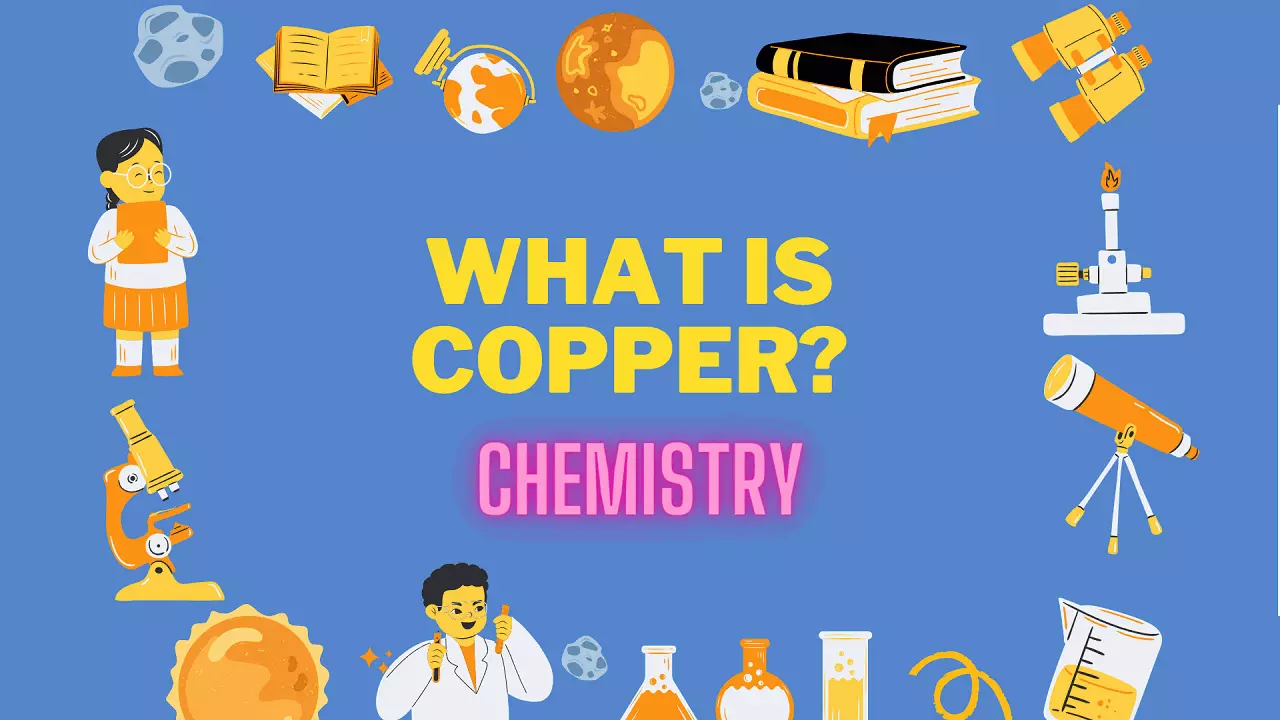
Copper - Electron configuration, Atomic number, Mass, Uses
What is Copper?
Copper is a ductile metal with a golden-pink color, occupying 29th place in the periodic table of chemical elements It is designated as Cu (Cuprum). The Latin name for copper comes from the island of Cyprus, where the largest copper mines were located in ancient times.
Mankind began to mine copper several millennia ago. The most ancient products found from this metal date back to the 7th-6th centuries BC. Among them are jewelry, tools, utensils and tools.
A big step forward in the development of metallurgy was the discovery of an alloy of copper and tin - bronze. This material was distinguished by increased strength and ability to be forged, due to which all products made from this copper alloy were of better quality.
Copper symbol & atomic number
The name copper comes from the Latin "cuprum" which designated Cyprus. The symbol of copper is Cu . This chemical element has an atomic number equal to 29. It is a transition metal.
Atomic Mass of Copper
Atomic mass of copper is 63 u. Copper has high density, melting point and boiling point. The melting point of copper is 1084°C; whereas the boiling point of copper is 2560°C; and the Density of copper is 8890 kg/m³.
General properties of copper |
|
|
Symbol of copper |
Cu |
|
Copper atomic number |
29 |
|
Family |
transition metal |
|
Group |
11 |
|
Period |
4 |
|
Block |
d |
|
Volumic mass |
8,96 g.cm-3 |
|
Hardness |
3 |
|
Color |
Rouge |
Atomic properties of copper |
|
|
Atomic mass of copper |
63 u |
|
Atomic radius of copper |
135 pm |
|
Copper electronic configuration |
[Ar] 4s1 3d10 |
|
Electrons per energy level |
2 | 8 | 18 | 1 |
|
Oxide |
Weakly basic |
Physical properties of copper |
|
|
ordinary state |
Solid |
|
Fusion point |
1084,62 °C |
|
Boiling point |
2562 °C |
First uses of copper
Copper was the very first metal used by man as early as 5000 BC. Indeed, it is one of the rare metals to be found pure in its native state, along with gold. This period defines what is known as the Copper Age.
This is why they immediately began to establish copper metallurgy. It had several uses, e.g. Weapons, Decorations, Jewelry, Washing up, Silverware etc.
Presence of Copper
Copper is a fairly abundant metal in some places on Earth. Copper can be found in its native state sometimes in the form of crystals and more regularly of threads, leaves and again in recovery of minerals. It also appears in mineral species such as basalts, sandstones and shales.
It can also be found in the form of oxides. Copper oxidizes in the form of cupric ions with the formula Cu2+ or cuprous ions with the formula Cu+. [ Read about Cupric Oxide]
There are open pit copper mines, where it is found in the form of sulphides. Its mines are located in various parts of the world such as Mexico, the United States, Chile and Peru.
Electronic configuration of copper
Copper is a transition metal that is part of the copper family along with gold and silver . It has a coppery color and a metallic shine that makes it stand out perfectly. The electronic configuration of copper is 1s2 2s2 2p6 3s2 3p6 4s1 3d10 .
You can also write the copper electron configuration in abbreviated form- [Ar] 4s1 3d10
The copper atom and Ni-1 , Zn+1 , Ga+2 , Ge+3 have the same electron configuration.
Copper has 29 electrons, that is why Copper atomic number is 29 and for its electronic configuration you can fill the electrons as per below-
- 2 electrons in 1s sublevel
- 2 electrons in 2s sublevel
- 6 electrons in 2p sublevel
- 2 electrons in 3s sublevel
- 6 electrons in 3p sublevel
- 1 electron in 4s sublevel
- 10 electrons in 3d sublevel
What is the oxidation state of Copper?
Copper atoms in compounds have oxidation states 4, 3, 2, 1, 0.
What are the quantum numbers of Copper?
Quantum numbers are determined by the last electron in the configuration; for Copper atoms, these quantum numbers have the value N = 3, L = 2, M l = -2, M s = ½ .
What is the Ionization energy of Copper?
The Ionization energy of Copper, Eo = 746 kJ/mol.
What is the valency of Copper?
The Copper valence characterizes the ability of the Cl atom to form chemical bonds. Copper atoms in compounds exhibit valence IV, III, II, I.
Isotopes of Copper
Copper has 29 known isotopes, their mass number ranging from 52 to 80. Its two most stable isotopes are copper-63 and copper-65, those found in nature. Its most stable radioisotope has a half-life of 61 hours and its most unstable has a half-life of 75 ns.
Physical and chemical properties of copper
- Copper is an orange-red metal. Its thermal and electrical conductivity capacities are very high. It is very malleable and ductile, almost soft.
- It is the third most consumed metal in the world, after silver and aluminium.
- In the open air, it deteriorates and we see a layer of green-grey color, called patina or verdigris, which covers the copper. It is carbon dioxide and not air that oxidizes copper.
- It is highly resistant to rust and corrosion.
- Most acids attack copper. It dissolves perfectly in nitric acid.
- Copper plays an important role in the photosynthesis process and is part of a protein involved in electron transport known as plastocyanin.
- In plants, we can find 70% of this element in chlorophyll, mainly the cellular organelles that deal with photosynthesis (chloroplasts).
copper production
- About 40% of the copper comes from recycled copper.
- The rest is produced from the extractions that took place in the copper mines.
- There are more than 18 million tons of copper produced per year.
- At the current rate of extraction, it is considered that the Earth's resources would be sufficient to continue its exploitation for 5 million years.
Uses of Copper
Almost all copper is used in its single body form, and sometimes in alloys with brass, zinc, bronze or even tin. Below are some of the uses of copper-
In architecture
Copper has long been used in architecture as a waterproof roofing material. It was often used in making domed roofs.
It has entered into the composition of many statues, the most famous of which is the Statue of Liberty, in the United States.
Uses in transport
Copper is used in different components of trucks and cars, basically in radiators due to its resistance to corrosion and its high thermal conductivity.
It is also used in bearings, brakes and naturally in electric motors and cables. Ultimately, ship hulls are almost always made of nickel and copper alloys to minimize fouling from marine life.
In industry
Copper is used in industry for making electrical conductors, thanks to its high conductivity. For example, it is used for electromagnets, switches and electrical relays.
Telecommunications and Electricity
Copper is a non-precious metal that has excellent electrical conductivity. This, together with its mechanical strength and ductility, make it the most widely used material for the manufacture of electrical cables for residential and industrial use.
Copper conductors are also used in many electrical equipment such as motors, generators, and transformers. The main alternative to copper for these applications is aluminium .
Most of the telephone cables are copper, these allow access to the Internet. The main alternatives to copper for telecommunications are wireless systems and fiber optics.
On the other hand, telecommunications and computer equipment is made up of copper to a lesser or greater extent. Some of them are internal wiring, transformers and integrated circuits.
coins
In the Middle Ages, coins began to be minted and copper was used as a raw material. On many occasions in its pure state and other times it was used in alloys such as cupro-nickel and bronze.
Medical use
Copper II sulphate is used as a fungicide to stop the development of algae in swimming pools and domestic ponds.
Radioactive isotopes of copper are used, such as copper-64 in radiography because it functions as a radioactive marker.
Its action can also be applied in radiotherapy for the treatment of cancer.
Ornamentation and Construction
A huge part of the networks that transport water are made of brass or copper thanks to their antibacterial properties and their resistance to corrosion, leaving lead pipes in disuse due to their harmful effects on human health.
Compared to plastic pipes, those made of copper have the benefit that they do not burn in the event of a fire and for this reason highly toxic gases and fumes are not released.
In what foods can we find copper?
We can find this element in a large number of foods, such as:
- Vegetables.
- oysters
- Seafood.
- Walnuts.
- Visors.
- Water, among others.
Know about more periodic elements- Gadolinium, Germanium Atomic Number, Neon, Promethium, Selenium, Terbium, Tellurium, Yttrium, Ytterbium Atomic Mass, Zirconium
Related Articales
Recently Posted
-
भगवान गौतम बुद्ध जीवन परिचय | Gautam Buddha in Hindi
December 15, 2022. -
कार्बन के अपररूप Allotropes of Carbon in Hindi
November 5, 2022. -
मिश्र धातु किसे कहते हैं? उपयोग, नाम, गुण Alloy in Hindi
July 27, 2022. -
गलनांक किसे कहते हैं? परिभाषा, उदाहरण Melting Point in Hindi
July 20, 2022. -
परिमाप किसे कहते हैं? Perimeter in Hindi
July 19, 2022.




